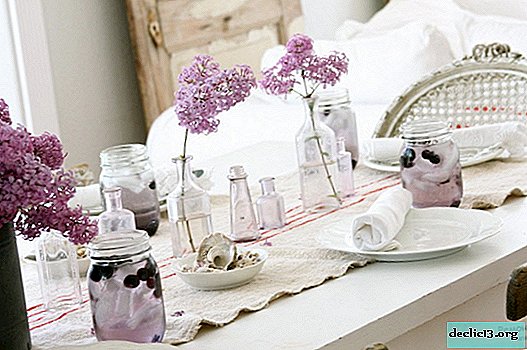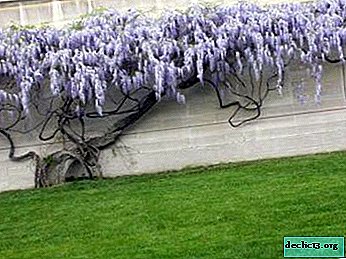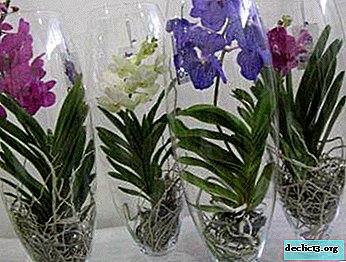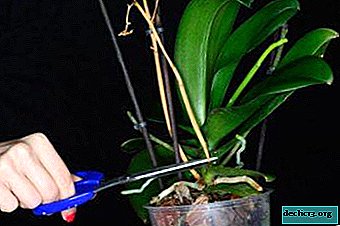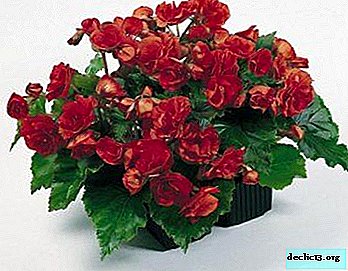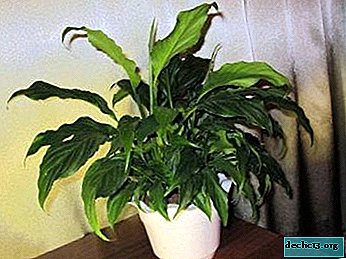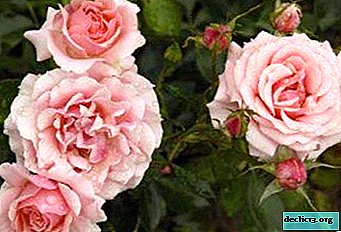Sagan daila or Adams rhododendron: history, description, benefits and photos of plants

Rhododendrons have long become not a strange plant, but the most fashionable and widespread. It’s not enough just to plant this shrub on your site, I want to come up with something especially interesting.
Now the hobby has gone to create, the so-called, blurry plantings, that is, to plant nearby groups of Rhododendrons, the shades of colors of which smoothly flow into each other.
In the article, we consider the features of the features and properties of Rhododendron Adams, as well as methods of its reproduction and pest control.
Brief definition
 Rhododendron Adams belongs to the evergreen species of the Rhododendron of the Heather family. This very small spread bush was known for a very long time as a medicinal plant. Then he did not yet have a modern name, in general, and now there are many completely different names.
Rhododendron Adams belongs to the evergreen species of the Rhododendron of the Heather family. This very small spread bush was known for a very long time as a medicinal plant. Then he did not yet have a modern name, in general, and now there are many completely different names.
In Buryatia, the doctors called him the sagan-dail (which means "white"), in addition, he is respectfully dubbed the white wing, fragrant shepherdess, Belogorsk tea, fragrant rosemary, fragrant rod, life-prolonging grass.
Detailed description
This is a low, densely branched shrub, its height can reach from 20 to 50 cm. It can form quite dense thickets due to creeping and dense branches.
Reference! Rhododendron Adams in Buryatia is listed in the Red Book.- Leaves - small, oblong - lanceolate, with rounded ends, not more than 2 cm in length. Young green leaves after a year change their color and become reddish-brown. The plant has a pleasant specific aroma thanks to the young green leaves.
- Flowers - medium-sized (1.5 cm in diameter) pink in various shades - from pale pink to saturated bright color. Do not smell, collected in inflorescences of 10 to 15 pieces at the tips of the branches.
- Bark - dark green in color, and closer to the base of the bush is brown.
- Root system - superficial.
Where and how does it grow in the wild?
In the wild, distributed in Mongolia, Southeast Asia, the Far East and Tibet. Rhododendron Adams perfectly withstands living conditions at an altitude of 2 thousand meters above sea level, protected by snow, withstands even severe frosts. Read about frost-resistant rhododendrons in this article.
You can meet him:
- in the mountains;
- forests;
- on the slopes;
- in the tundra.
In general, this curious shrub prefers a moderately moist cool climate.
History of occurrence
During the expedition, this plant was very interested in the famous researcher of Siberia I.O. Adams, who later described it in detail.
All the scientific world Rhododendron Adams became known after the publication of the Moscow Society of Naturalists. Actually, in honor of him, Rhododendron received this name.
What is the difference from the rest of the species?
This view is different from the rest:
- high frost resistance;
- short stature;
- the aroma of young leaves.
Photo
And this is how Sagan-daila looks like.





Healing properties
For many years, Rhododendron Adams has been widely used in folk medicine., with its help, strength was restored, it acts on the human body as an energetic (therefore, it is better not to take it after lunch). A very wide range of its medicinal properties:
- improves brain function;
- normalizes the work of the heart and kidneys;
- perfectly anesthetizes and relieves migraines;
- normalizes metabolism;
- possesses antipyretic properties;
- helps in the treatment of diseases of the nervous system, fever, rheumatism and many others.
This plant is compared by many with Ginseng for its beneficial properties. Rhododendron Adams has a very rich chemical composition:
- Essential oils.
- Various acids.
- Resinous substances.
- Phenol.
- Tannins.
- Andromedoxin.
- Tannids and others.
What can be prepared from a plant?
Tea
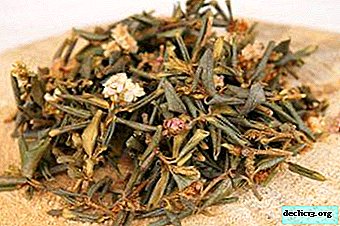 To prepare tea (and tinctures), tops of shoots with leaves are harvested in the summer, as soon as the flowers begin to bloom.
To prepare tea (and tinctures), tops of shoots with leaves are harvested in the summer, as soon as the flowers begin to bloom.- Dry the prepared raw materials under a canopy, grind and store in closed glass jars or linen bags, in a dark, dry place.
- Then they are used in the following proportions: one teaspoon of the resulting tea is brewed with a glass of boiling water and insisted for about 10 minutes.
Tincture
For the manufacture of tinctures, the proportions are taken 1: 10 (that is, 1 part of raw materials and 10 parts of vodka), having stood for a week at room temperature (in a dark place), the tincture is ready.
Bloom
The timing
This shrub blooms throughout the summer with spherical inflorescences. of many delicate flowers of elongated shape.
Care before and after
Before flowering, you need to equip Rhoedondron Adams with a suitable place, watering and feeding, do not forget to spray, and after flowering, first of all, remove all the flower stalks so that the seeds do not begin to ripen and also do not forget about feeding.
Also after flowering, you need to remove all dried leaves and make a pinch for a better formation of the bush (the most suitable time). It is worth saying that mass harvesting of raw materials (branches) as in natural conditions is better not necessary.
Important! So that the plant does not die, it is allowed to rip only a few leaves from one branch.If not blooming
This rarely happens, but if suddenly the bush does not bloom, then you have planted it wrong, transplant to another place.
Use in garden design
 Rhododendron Adams will look great on the northern slopes, alpine hills, on the north side of the house.
Rhododendron Adams will look great on the northern slopes, alpine hills, on the north side of the house.
At the same time, the plant feels quite comfortable in the garden. At least Rhododendron Adams blooms on the condition of leaving extremely rarely.
It is better to plant several copies at once tightly to each other. Given the flowering period - all summer, you can create spectacular compositions with other types of Rhododendron.
Ennoble shrub
Seat selection
An ideal choice would be a place in a small partial shade or on the north side of the house. You can plant it on an alpine hill on the north side, on any northern slopes - these are places close to natural.
What should be the soil?
Naturally, the composition of the soil plays a very large role for the full growth of Rhododendron Adams. On heavy dense soils, it simply will not be able to grow, be sure the composition must be loose. Next in importance is acidity, we need a slightly acidic soil. These are the two most important conditions when choosing a soil.
Landing
Only when the earth warms up well (not earlier than the end of April). You can plant a seedling, or you can sow seeds and get your own seedlings, this is a very good method, since they usually have high germination rate and they can immediately plant several plants. In the spring, we sow seeds in a bowl of sand and peat and send everything to a small plate.
Attention! Seeds will germinate for approximately one month (or slightly less).After the emergence of seedlings, we wait another month and we dive seedlings into pots. For them, at this time a cool temperature is required (not higher than 20 degrees), you can plant in the garden in spring or the next canopy.
Temperature
He is not afraid of frost, is able to hold out at minus 32 degrees, he tolerates heat worse (lover of a cool climate). The maximum possible temperature for Rhododendron Adams is plus 25 degrees. Ideally, it would be good to grow at temperatures from minus 15 to plus 15 degrees.
Watering
Moderate, it is worth watering as soon as the leaves slightly begin to lose their elasticity. It is important to create moisture around the plant, to spray more often).
Top dressing
Fertilizer should be applied twice a season - in April and in September. Use the best fertilizer for flowering shrubs.
Pruning
It’s just that you don’t need to cut anything, if only there was a need to rejuvenate an old plant, then in early spring you can cut off unnecessary shoots and immediately lubricate the wounds with garden var.
Transfer
 You can transplant the plant at any time of the active season, except in late autumn (so that it is not weakened by winter).
You can transplant the plant at any time of the active season, except in late autumn (so that it is not weakened by winter).
The main point in this process is to save a whole lump of land, so you need to carefully dig out the bush from the old place and transfer it to the prepared landing pit.
It is better to do this together - you need to keep the bush evenly and carefully bury it, ramming the soil a little on the sides. At the end of the transplant, the bush should be well watered and mulched.
Preparation for winter
This variety winters well, but you still need to play it safe. It is best to fill it with pine needles, when the frost starts, they will perfectly protect Rhododendron.
The shrub is very low and if you periodically pour snow on it so that it is in the cold in the snow, then there will be no problems with wintering.
Breeding
Adams rhododendron is most reliable propagated in two ways:
- seeds;
- division of the bush.
Reproduction by seeds is no different from reproduction of other species of Rhododendrons. By dividing the bush, it is easiest to propagate a relatively young bush during transplantation.
It is necessary to cut the root system in half and divide the shoots, treat with charcoal, leave for 5 minutes, then plant them in the right place. It is advisable to spray these plants more often.
Diseases and Pests
The most common pests:
- aphid;
- mealybug;
- scale shield;
- spider mite.
Insecticide treatment will help get rid of pests.
 The most dangerous diseases:
The most dangerous diseases:
- chlorosis;
- sheet mosaic;
- divorces;
- rust;
- spotting.
All these are manifestations of fungal diseases. To treat these problems, the plant must be timely and thoroughly treated with copper sulfate.
Prevention of various problems
For prevention, you need to treat the bush with Bordeaux liquid in spring and autumn.
Conclusion
What conclusion can be made - if you really want and try hard, then you can grow everything in your garden. When growing Rhododendron Adams at home, you need to be prepared for the fact that this is an independent and very capricious instance, and he does not really want to "domesticate". It will be easier for him to adapt to garden conditions when planting seeds.

 To prepare tea (and tinctures), tops of shoots with leaves are harvested in the summer, as soon as the flowers begin to bloom.
To prepare tea (and tinctures), tops of shoots with leaves are harvested in the summer, as soon as the flowers begin to bloom.